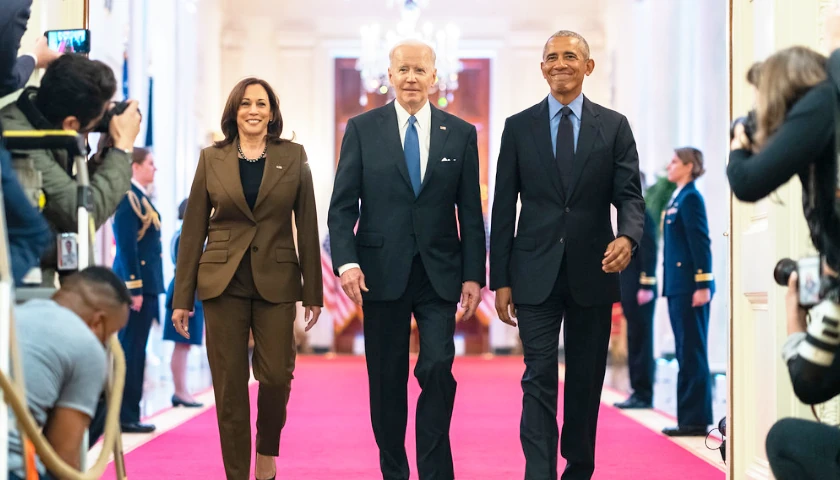On Friday’s one-hour radio show from Star News Digital Media, in the early stages of a national weekend syndication roll-out – The Battleground State Report with Steve Gill, Michael Patrick Leahy, and Doug Kellett – the hosts discussed the record-setting government spending. With Kellett out, Gill and Leahy noted that even after tax cuts, Americans are currently sending money in record-breaking amounts to Washington yet somehow the government is still unable to properly budget.
Gill: The tax cuts that were imposed last year have increased revenue dramatically. We are breaking records in terms of the amount of tax dollars being sent to Washington, D.C. despite the tax cuts. I mean we always hear, “Well if you cut taxes we’ll get less money. We aren’t going to be able to afford things.” The tax cuts have actually increased the amount of money being sent to Washington. We’ve seen revenue increase something like six percent.
I’m sorry we’ve seen revenue increase about 2.7 percent. The problem is they’ve increased spending six percent. We’re sending more than ever but they keep spending it still faster than we can send it because there are no efforts to actually reign in the spending in Washington, D.C. Make those cuts that you have duplicative spending in this department, this agency, this division. They don’t deal with the spending side.
And even though again we’re sending record levels of money to Washington, we’re seeing the deficit rise. We’re seeing the debt load increase. And that’s what the media is talking about. “Oh, we’re going deeper in debt!” It’s because the Republicans and Democrats can’t pass a budget because they’ll threaten to shut down the government rather than do something reasonable. So keep in mind when you hear all these, “Oh it’s the biggest debt in history!” It’s the most money Americans have ever sent to Washington in history after tax cuts.
Leahy: So here’s the interesting thing, if you look at federal spending as a percentage of GDP, right? It reached a high in the non World War II era. In 2009, that was the last fiscal year that President Obama was responsible for. 24.3 percent. That was dangerously high. It is now under President Trump, it sort of stabilized at about 20 percent. In fact, in 2018, it was about 20 percent down from where it’s been. So generally speaking, you know the old saying, ‘a rising tide lifts all boats’, even though the federal deficit is not under control.
Because the economy has been growing federal spending as a percentage of GDP is down somewhat to twenty percent. Now really I had written in a book I wrote in 2012 called ‘Covenant of Liberty.’ When we were looking at a 24 percent GDP I thought that we really had to get spending under control because of this built in programmatic bias towards more and more spending. I said, “Look, if we don’t get it under control and start bringing it down it’s just inevitably going to go up.” Under Democrats it will go back up.
Gill: Well than with Democrats controlling the House you can’t get a legitimate budget.
Leahy: Hmm hmm.
Gill: You have to have a President, a Republican House and a Republican Senate able to trim back some of this stuff. And Michael, even with rolling five and a half million people off food stamps. Even with rolling more and more people off the welfare rolls.
Off the unemployment roles where they go from being a tax burden to a tax contributor. Even with that we’re still not seeing any cuts because the whole system as you pointed out in your book is built to increase spending. They don’t start each budget year (and they haven’t passed a legitimate budget in over a decade).
Leahy: Right because they don’t go through the process.
Gill: They don’t start with, “Here’s what we spent last year. Do we need more or less?” They increase the spending based upon a projected increase and then if you reduce the amount of increase you get left doing groups and others screaming, “Oh, they’re cutting spending!” You’re not cutting it if your spending more than you did before.
And yet if you don’t spend as much more as they want they call that a cut. And so it’s all built with this momentum of increase spending and never ratcheting back and never making the tough decisions like families have to do. “We don’t have enough money, what do we cut?” Washington never does that.
Leahy: Now I’d argue that its in the best interest of the country to literally cut federal spending in half. So that federal spending as a percentage of GDP should be 12 percent. The last time we were in that range was between 1948 when it was 10.8 percent federal spending as a percentage of GDP and then it rose to 13.1 percent in 1951.
It’s been climbing pretty much ever since and hit a peak of 24.3 percent in 2010. Stabilized at about 20 percent but not going down. And it really should.
Listen to the Battleground State Report here:
– – –
Tune in every Friday morning and listen to The Battleground State Report with Steve Gill, Michael Patrick Leahy, and Doug Kellett.





